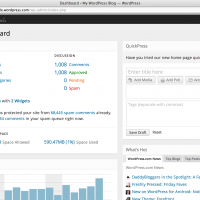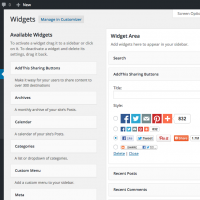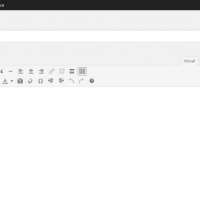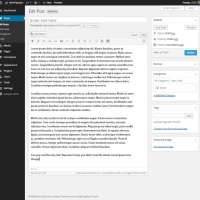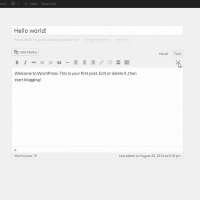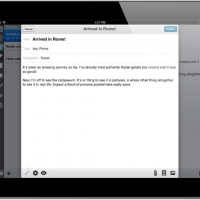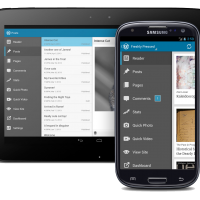Case Study: WordPress CMS

Case Study: WordPress CMS

- Wordpress Dashboard
- Widgets
- Visual Editor
- Visual Editor
- Distraction Free Editor
- Wordpress iPhone App
- Wordpress iPad App
- Wordpress Android App
Case Study: Wordpress CMS
The Content Management System: Meet WordPress
WordPress is Image Associates’ preferred Content Management System. We have used other CMS’s in the past, but in the here and now, nothing can compare with WordPress for ease of use, extensibility, and compatibility. WordPress is an open source project with a vast pool of contributing developers. It is standards compliant, ADA compliant, and cross-platform compatible. It is highly extensible through the use of plug-ins that cover additional functionality. It continues to grow and evolve with the ever-changing web. It is stable and futureproof. It is extremely well-documented.
Unlike some CMS’s, particularly those that rely on Microsoft’s ASP.NET, the barrier for entry for developers is low, meaning you will always be able to find developers for this platform. This large pool of developers also provides one of the largest repositories of plug-ins of any CMS. Any function you can imagine is likely already covered by multiple plug-in options. Additionally, creation of custom plug-ins is a well-documented task that nearly any php programmer can accomplish.
The WordPress experience is highly customizable for site administrators and content contributors, as well as highly theme-able for front-end users. Unneeded features can be turned off for novice users and enabled for advanced users. User management can be as broad or as granular as you wish.
Content Management includes highly advanced taxonomical options, from categories and tags to custom post types that allow content to be broken up into any organizational structure necessary. The same type of taxonomical management of text content can also be applied to downloadable files, external links, employee or staff directories, etc through the use of plug-ins.
Themes can be customized and previewed before use, and can be built to accomodate the use of widgets that offer a variety of additional content display or functionality. Furthermore, WordPress is SEO (Search Engine Optimization) friendly and can be optimized using caching and CDN’s (Content Delivery Network) where necessary.
Content Updates
WordPress excels at keeping content clean and simple. Content editing takes place in a clean editor capable of distraction-free editing OR content can be edited inline directly on the page via the use of a “front-end editing” plugin. The default toolset used by the WordPress visual editor is designed to help content creators follow best practices for web content and styling, but tools can be added as needed. The editorial workflow in WordPress includes the ability to assign content on a user by user basis and allows moderation and approval before publication as well as scheduling of content. An HTML editor is provided for more advanced content entry. The editors available to each user can be specified within that user’s profile setting by the site administrator. Images can be uploaded directly into content pages and stored for use elsewhere in the site.
And though we do not endorse or recommend the use of Microsoft Word or any similar word processor for the creation or editing of web content, the editor also has a “paste as Text” mode which allows content posted from Word to be cleaned of all the extraneous “junk code” that typically accompanies word processor text before final inclusion in the content page.
WordPress captures the date, time and user ID whenever content is added or updated. It also keeps track of revisions and allows for the recovery of past versions of a post. WordPress provides tags for use with its templates to display any or all of such information on the front end with each post.
WordPress allows for multiple users and the assignment of different user roles, such as “editor”, “author” and “contributor” which allow different levels of access and different publication rights. Content in the backend is filterable by author so all an author’s work can be viewed in list form. The editorial workflow in WordPress includes the ability to assign content on a user by user basis and allows moderation and approval before publication as well as scheduling of content. All content can be held for approval by a user with the rights to publish before anything is seen by the public.
As stated above, WordPress content editor tools can be customized per user. Novice users should only be given access to the WYSIWYG tool which limits the amount of formatting that can be applied, thus protecting the overall site design from inexperienced users. All novice users should have their user roles set to require approval by a higher level user or the webmaster before any of their content is made live on the site.
A robust widget system allows inclusion of various content types in well organized sidebars that can appear on any or all pages. Other content types can be created and inserted into pages via the WordPress shortcode system, which allows flexibility to include even advanced code for dynamic content on any page.
Webmaster Notification
WordPress includes the ability to notify the admin of changes to content. Plug-ins are available to add even more granularity to the notification process.
WordPress provides a “Preview” button to allow the content author to see what their content will look like within the context of the visual theme prior to submitting their post for approval.
Spelling and Grammar
WordPress offers spellcheck in its WYSIWYG editor with inline correction. More advanced grammar and proofreading plug-ins are also available. We often recommend that heavy users utilize a browser plug-in, which works using your computer’s resources and offers improved performance.
Mobility
WordPress offers a variety of external methods of adding or updating site content, including posting via email and a seasoned iOS and Android app for mobile phones and tablets that allows for site management as well as content creation.
Additional CMS features
- WordPress is SEO friendly out of the box. In fact, CMS2CMS notes that “WordPress has … strong SEO features. Due to the fact that WP is favoured by Google, you can easily boost up the traffic to your site.”
- WordPress provides the ability to create multiple templates that can be applied to content on a page by page basis or category basis.
- All WordPress content is stored in a database and is therefore searchable by default.
- We provide a print style sheet in the Cascading Style Sheets for reformatting the web page content for ease of printing. If more advanced print capabilities are required, then we will once again turn to the vast WordPress plug in repository.
- RSS, forms and calendars are a simple addition either in the default installation or through the use of plug ins. We will utilize a contact management plug in to organize and display the staff directories.
- Video players and image galleries/slideshows are readily available as plug ins.
WordPress vs. Kentico
Research finds that WordPress compares equally or favorably to Kentico in nearly every category. However, when it comes to usage, WordPress is dominant. This is not surprising given the fact that WordPress in open source and free to use, whereas Kentico is a proprietary CMS that runs on proprietary server software and costs upwards of $3000 to implement. Hosting costs also increase due to the proprietary nature of the ASP servers required by Kentico. The large user base of WordPress has the benefit of fostering a large and diverse user and developer community. The website CMS2CMS puts this into perspective by pointing out:
“It is necessary to note that Kentico CMS has relatively small community. This means that the forums can be less reliable. In case you are using the free license, your only support is the forums. To put it another way, if you have some questions about your site management, this could be a problem.”
Conversely, the extensive WordPress community means that knowledge and support and extensibility are readily available, both at the WordPress forums and around the web, at sites like StackExchange, which has an entire section devoted to WordPress questions and answers.
The larger availablity of WordPress means a larger pool of developers. When comparing each platform for availability of extensibility plug-ins offering customized functionality, CMS2CMS notes that Kentico’s lack of third party options are “a drawback for users who are dissatisfied with the components that Kentico has to offer.” Conversely, they note that “WordPress comes shipped with a gazillion of free and premium plugins allowing to further scale and customize the site as needed”.
A large developer community also means that the client will never have difficulty finding developers to enhance or take over the site in the foreseeable future. And the active development cyle of WordPress means more nimble response to security issues or future functionality that may sweep the net as time marches on.
References:
- https://www.g2crowd.com/compare/kentico-vs-wordpress
- https://www.datanyze.com/market-share/CMS/kentico-vs-wordpress.org/
- https://www.similartech.com/compare/kentico-vs-wordpress
- http://w3techs.com/technologies/comparison/cm-kentico,cm-wordpress
- https://www.trustradius.com/compare-products/kentico-vs-wordpress

